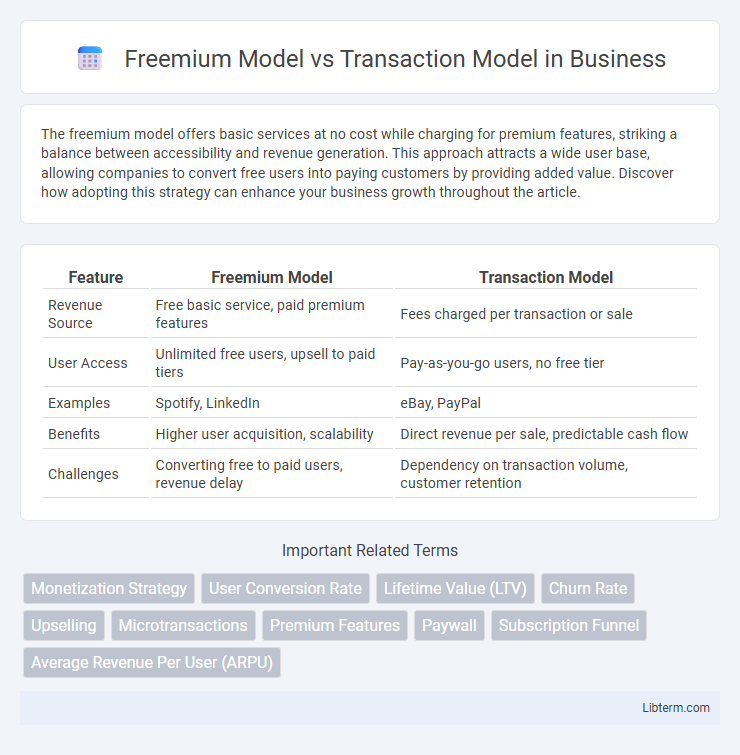The freemium model offers basic services at no cost while charging for premium features, striking a balance between accessibility and revenue generation. This approach attracts a wide user base, allowing companies to convert free users into paying customers by providing added value. Discover how adopting this strategy can enhance your business growth throughout the article.
Table of Comparison
| Feature | Freemium Model | Transaction Model |
|---|---|---|
| Revenue Source | Free basic service, paid premium features | Fees charged per transaction or sale |
| User Access | Unlimited free users, upsell to paid tiers | Pay-as-you-go users, no free tier |
| Examples | Spotify, LinkedIn | eBay, PayPal |
| Benefits | Higher user acquisition, scalability | Direct revenue per sale, predictable cash flow |
| Challenges | Converting free to paid users, revenue delay | Dependency on transaction volume, customer retention |
Introduction to Freemium and Transaction Models
The freemium model offers basic services for free while charging for premium features, encouraging user acquisition and gradual monetization. In contrast, the transaction model generates revenue by charging fees for each individual purchase or transaction made on the platform. Both models serve distinct business strategies: freemium aims to build a large user base with optional upgrades, whereas transaction models focus on direct revenue from completed sales.
Key Differences Between Freemium and Transaction Approaches
The Freemium model offers basic services for free while charging for premium features, emphasizing user acquisition and long-term engagement. The Transaction model generates revenue directly from each sale or exchange, focusing on individual customer purchases. Key differences include revenue timing, with Freemium relying on conversion rates over time and Transaction models depending on immediate payment per transaction.
How the Freemium Model Works
The Freemium model offers basic services for free while charging users for advanced features, premium content, or enhanced functionalities, effectively attracting a large user base without upfront costs. By converting a small percentage of free users into paying customers, companies generate revenue through subscriptions, in-app purchases, or feature upgrades. This model leverages user engagement and network effects to maximize long-term monetization potential compared to the Transaction model, which earns revenue solely from individual sales or usage fees.
Understanding the Transaction Model
The transaction model generates revenue by charging customers a fee for each individual sale or exchange, making it ideal for businesses with variable sales volumes. This model aligns income directly with user activity, ensuring scalability and predictable revenue streams based on transaction frequency and value. Understanding customer behavior and optimizing transaction fees are critical to maximizing profitability within this model.
Pros and Cons of the Freemium Model
The Freemium model offers users free basic services while charging for premium features, enabling rapid user acquisition and market penetration with minimal entry barriers. However, its reliance on a small percentage of paying customers can limit revenue scalability and strain resources supporting free users. This model may also lead to challenges in balancing feature restrictions to encourage upgrades without alienating the user base.
Advantages and Disadvantages of the Transaction Model
The transaction model offers clear advantages such as immediate revenue generation and alignment of income with actual sales, making it highly scalable for businesses fluctuating in demand. However, it can face disadvantages including potential customer friction due to frequent payment requests and revenue instability during low transaction periods. This model also necessitates robust payment processing infrastructure and can limit long-term customer loyalty compared to subscription-based alternatives.
Revenue Generation: Freemium vs Transaction
The Freemium Model drives revenue by offering free basic services while charging for premium features, encouraging user growth and upselling opportunities. In contrast, the Transaction Model generates income directly from each user transaction, providing immediate and consistent cash flow per sale. Businesses leveraging Freemium rely on converting a percentage of free users to paid plans, whereas Transaction Model companies benefit from volume and frequency of purchases.
User Experience and Customer Retention
The Freemium Model enhances user experience by offering free access to core features, encouraging trial and long-term engagement while minimizing initial barriers, which boosts customer retention through ongoing value perception. In contrast, the Transaction Model prioritizes seamless and secure purchase processes, ensuring efficient user interactions that foster trust and repeated transactions, directly influencing retention rates. Both models require tailored strategies to optimize user satisfaction, with Freemium focusing on sustained feature engagement and Transaction Model emphasizing transactional ease and reliability.
Industry Examples: Successful Freemium and Transaction Strategies
Spotify exemplifies the successful freemium model by offering free, ad-supported streaming alongside premium subscriptions that enhance user experience with offline listening and higher audio quality. In contrast, Amazon employs a transaction model, generating revenue primarily through direct sales and fees on its vast marketplace platform. Both strategies drive significant growth in their respective industries by aligning monetization methods with user behavior and market demands.
Choosing the Right Model for Your Business
Choosing the right business model depends on your revenue goals and customer engagement strategy, with the Freemium Model ideal for driving user acquisition through free basic services and upselling premium features. The Transaction Model suits businesses reliant on direct sales, generating revenue from each customer purchase without offering free tiers. Analyze customer behavior, market demand, and cost structure to determine whether recurring revenue from Freemium or per-transaction income aligns best with your long-term growth objectives.
Freemium Model Infographic

 libterm.com
libterm.com